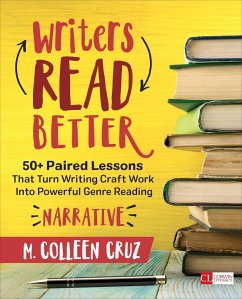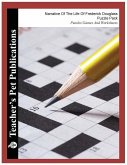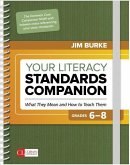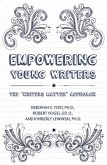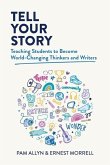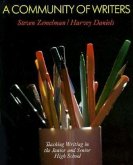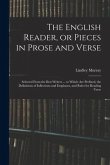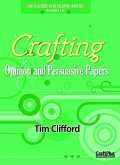M Colleen Cruz
Writers Read Better: Narrative
50+ Paired Lessons That Turn Writing Craft Work Into Powerful Genre Reading
M Colleen Cruz
Writers Read Better: Narrative
50+ Paired Lessons That Turn Writing Craft Work Into Powerful Genre Reading
- Broschiertes Buch
- Merkliste
- Auf die Merkliste
- Bewerten Bewerten
- Teilen
- Produkt teilen
- Produkterinnerung
- Produkterinnerung
By flipping the traditional "reading lesson first, writing lesson second" sequence, Colleen Cruz helps teachers make the most of the writing-to-reading connection with 50 carefully matched lesson pairs centered around narrative texts.
Andere Kunden interessierten sich auch für
![Puzzle Pack: Narrative of the Life of Frederick Douglass Puzzle Pack: Narrative of the Life of Frederick Douglass]() Mary B. CollinsPuzzle Pack: Narrative of the Life of Frederick Douglass28,99 €
Mary B. CollinsPuzzle Pack: Narrative of the Life of Frederick Douglass28,99 €![Your Literacy Standards Companion, Grades 6-8 Your Literacy Standards Companion, Grades 6-8]() Jim BurkeYour Literacy Standards Companion, Grades 6-844,99 €
Jim BurkeYour Literacy Standards Companion, Grades 6-844,99 €![Empowering Young Writers Empowering Young Writers]() Deborah S YostEmpowering Young Writers30,99 €
Deborah S YostEmpowering Young Writers30,99 €![Tell Your Story Tell Your Story]() Pam AllynTell Your Story34,99 €
Pam AllynTell Your Story34,99 €![A Community of Writers A Community of Writers]() Steven ZemelmanA Community of Writers57,99 €
Steven ZemelmanA Community of Writers57,99 €![The English Reader, or Pieces in Prose and Verse; Selected From the Best Writers ... to Which Are Prefixed, the Definitions of Inflections and Emphase The English Reader, or Pieces in Prose and Verse; Selected From the Best Writers ... to Which Are Prefixed, the Definitions of Inflections and Emphase]() Lindley MurrayThe English Reader, or Pieces in Prose and Verse; Selected From the Best Writers ... to Which Are Prefixed, the Definitions of Inflections and Emphase24,99 €
Lindley MurrayThe English Reader, or Pieces in Prose and Verse; Selected From the Best Writers ... to Which Are Prefixed, the Definitions of Inflections and Emphase24,99 €![Crafting Opinion and Persuasive Papers: For Teachers of Developing Writers in Grades 4-10 Crafting Opinion and Persuasive Papers: For Teachers of Developing Writers in Grades 4-10]() Tim CliffordCrafting Opinion and Persuasive Papers: For Teachers of Developing Writers in Grades 4-1018,99 €
Tim CliffordCrafting Opinion and Persuasive Papers: For Teachers of Developing Writers in Grades 4-1018,99 €-
-
-
By flipping the traditional "reading lesson first, writing lesson second" sequence, Colleen Cruz helps teachers make the most of the writing-to-reading connection with 50 carefully matched lesson pairs centered around narrative texts.
Hinweis: Dieser Artikel kann nur an eine deutsche Lieferadresse ausgeliefert werden.
Hinweis: Dieser Artikel kann nur an eine deutsche Lieferadresse ausgeliefert werden.
Produktdetails
- Produktdetails
- Verlag: Sage Publications
- Seitenzahl: 312
- Erscheinungstermin: 27. Juni 2019
- Englisch
- Abmessung: 231mm x 185mm x 23mm
- Gewicht: 612g
- ISBN-13: 9781506349442
- ISBN-10: 1506349447
- Artikelnr.: 54923626
- Herstellerkennzeichnung
- Libri GmbH
- Europaallee 1
- 36244 Bad Hersfeld
- 06621 890
- Verlag: Sage Publications
- Seitenzahl: 312
- Erscheinungstermin: 27. Juni 2019
- Englisch
- Abmessung: 231mm x 185mm x 23mm
- Gewicht: 612g
- ISBN-13: 9781506349442
- ISBN-10: 1506349447
- Artikelnr.: 54923626
- Herstellerkennzeichnung
- Libri GmbH
- Europaallee 1
- 36244 Bad Hersfeld
- 06621 890
Colleen Cruz is the author of several titles for teachers, including The Unstoppable Writing Teacher, as well as the author of the young adult novel, Border Crossing, a Tomás Rivera Mexican American Children's Book Award Finalist. She was a classroom teacher in general education and inclusive settings before joining the Teachers College Reading and Writing Project, where she shares her passion for accessibility, twenty-first century learning, and social justice as the Director of Innovation.
List of Videos
Solutions at a Glance
Acknowledgments
Introduction: Preparing for Aligned or Complementary Units on Narrative
Reading and Writing
PART 1: LESSONS FOR GENERATING STORY: ENVISIONING CHARACTERS AND SETTINGS
LESSON 1
Writing: Write Our Truest Selves
Reading: Characters Offer Clues to Authors' Selves
LESSON 2
Writing: Flaws and Quirks for Character Development
Reading: Studying Flaws to Seek Deeper Meaning
LESSON 3
Writing: Finding Freedom in Familiar Character Types
Reading: Identifying Archetypes to Develop Depth of Understanding
LESSON 4
Writing: Maps, Photographs, and Songs as Tools for Setting Creation
Reading: Connecting Setting to Meaning
LESSON 5
Writing: Letting Characters and Settings Lead Us to Story
Reading: Following the Path of a Story to Understand Other Elements
LESSON 6
Writing: Finding Important Ideas in the Most Personal Piece of Our Lives
Reading: Focusing on the Details of a Text to Uncover Bigger Notions
LESSON 7
Writing: Studying Places for Stories to Explore
Reading: Making the Connection Between Place and an Author's Message
LESSON 8
Writing: Revising the Arc to Match the Meaning
Reading: Connecting the Shape of the Plot to the Theme
FOR DIGITAL CLASSROOMS
Writing: Apps and Tools to Help Keep Track of Story Ideas
Reading: Reading Stories Digitally Requires Readers to Purposefully Set
Themselves up to Reread
PART 2: LESSONS FOR DRAFTING A NARRATIVE, FOLLOWING PLOT, AND FINDING
SIGNIFICANCE
LESSON 9
Writing: Draft Fast to Create Energy
Reading: Reading Voluminously to Build Momentum
LESSON 10
Writing: Drafting Stand-Alone Scenes
Reading: Studying One Scene for Larger Understanding
LESSON 11
Writing: Deciding When to Summarize
Reading: Summarizing Text to Check for Comprehension
LESSON 12
Writing: Research for Personal Writing
Reading: Noting When a Writer Uses Research or Artifacts
LESSON 13
Writing: Drafting With Truth in Mind, Leaving Space for Facts
Reading: Deciphering an Author's Truth and Perspective
LESSON 14
Writing: Drafting With Perspective in Mind
Reading: Considering the Author's Choice of Perspective and Its Effects
LESSON 15
Writing: Research Makes Fiction Believable
Reading: Researching Outside a Text Can Open New Interpretations
FOR DIGITAL CLASSROOMS
Writing: Choosing the Best Platform for Your Story
Reading: The Platform Affects the Way You Interact With a Story
PART 3: LESSONS FOR REVISING FOR MEANING AND SIGNIFICANCE: ANALYSIS AND
CRITIQUE
LESSON 16
Writing: Exploring Deeper Meaning in Drafts to Begin Revision
Reading: Identifying an Author's Deeper Meaning Through Rereading and
Writing
LESSON 17
Writing: Compelling Stories Thrive on Conflict
Reading: Identifying the Scenes That Point to Conflict in a Story
LESSON 18
Writing: Craft Settings That Connect With Characters' Emotions
Reading: Noticing a Relationship Between Setting and Character
LESSON 19
Writing: Stories Extend and Elaborate on Larger Ideas
Reading: Tracking the Weight of a Story
LESSON 20
Writing: Increasing Suspense Through Revision
Reading: Spotting Moves Authors Use to Build Suspense Helps Readers Make
Predictions
LESSON 21
Writing: Craft Dialogue to Match Character Personality and Uniqueness
Reading: Dialogue Gives Insights Into Characters
LESSON 22
Writing: The Narrator's Voice Makes Perspective Clear
Reading: The Narrator's Voice Sets up a Reader's Inferences and
Interpretations
LESSON 23
Writing: Knowing the Significance of a Personal Story Can Help Writers to
Foreshadow
Reading: Identifying Foreshadowing in a Story to Help Discover Theme
FOR DIGITAL CLASSROOMS
Writing: Revising Digitally Allows for Powerful Peer Feedback
Reading: Other Readers Can Give New Perspectives
PART 4: LESSONS FOR PERFECTING THE PROSE AND PURPOSE: DEEP INTERPRETATION
LESSON 24
Writing: Designing Beginnings and Endings That Entice and Linger
Reading: Savoring Beginnings and Endings
LESSON 25
Writing: Fewer Words Can Make More Impact
Reading: Considering Words Used and Not Used When Interpreting
LESSON 26
Writing: Using Symbolism to Give Readers Direction
Reading: Interpreting Symbols in Stories-When Everything Can Have Meaning
LESSON 27
Writing: Choosing and Smoothing Tense
Reading: Looking to Tense for Meaning
LESSON 28
Writing: The Many Purposes of Narrative Paragraphs
Reading: Reading Narrative Paragraphs on Surface and Inferential Levels
LESSON 29
Writing: Using Tools to Make Smart Spelling Decisions
Reading: Knowing an Author Carefully Chooses Words Helps Readers Develop
Deeper Understanding
LESSON 30
Writing: Making Publishing Decisions Based on the Intended Audience
Reading: Judging the Effectiveness of an Author's Decisions
FOR DIGITAL CLASSROOMS
Writing: Using Digital Tools to Call Attention to Theme
Reading: Looking Across Highlights, Bookmarks, and Notes to Help Identify
Unifying Themes
Resources
References and Further Reading
Index
Solutions at a Glance
Acknowledgments
Introduction: Preparing for Aligned or Complementary Units on Narrative
Reading and Writing
PART 1: LESSONS FOR GENERATING STORY: ENVISIONING CHARACTERS AND SETTINGS
LESSON 1
Writing: Write Our Truest Selves
Reading: Characters Offer Clues to Authors' Selves
LESSON 2
Writing: Flaws and Quirks for Character Development
Reading: Studying Flaws to Seek Deeper Meaning
LESSON 3
Writing: Finding Freedom in Familiar Character Types
Reading: Identifying Archetypes to Develop Depth of Understanding
LESSON 4
Writing: Maps, Photographs, and Songs as Tools for Setting Creation
Reading: Connecting Setting to Meaning
LESSON 5
Writing: Letting Characters and Settings Lead Us to Story
Reading: Following the Path of a Story to Understand Other Elements
LESSON 6
Writing: Finding Important Ideas in the Most Personal Piece of Our Lives
Reading: Focusing on the Details of a Text to Uncover Bigger Notions
LESSON 7
Writing: Studying Places for Stories to Explore
Reading: Making the Connection Between Place and an Author's Message
LESSON 8
Writing: Revising the Arc to Match the Meaning
Reading: Connecting the Shape of the Plot to the Theme
FOR DIGITAL CLASSROOMS
Writing: Apps and Tools to Help Keep Track of Story Ideas
Reading: Reading Stories Digitally Requires Readers to Purposefully Set
Themselves up to Reread
PART 2: LESSONS FOR DRAFTING A NARRATIVE, FOLLOWING PLOT, AND FINDING
SIGNIFICANCE
LESSON 9
Writing: Draft Fast to Create Energy
Reading: Reading Voluminously to Build Momentum
LESSON 10
Writing: Drafting Stand-Alone Scenes
Reading: Studying One Scene for Larger Understanding
LESSON 11
Writing: Deciding When to Summarize
Reading: Summarizing Text to Check for Comprehension
LESSON 12
Writing: Research for Personal Writing
Reading: Noting When a Writer Uses Research or Artifacts
LESSON 13
Writing: Drafting With Truth in Mind, Leaving Space for Facts
Reading: Deciphering an Author's Truth and Perspective
LESSON 14
Writing: Drafting With Perspective in Mind
Reading: Considering the Author's Choice of Perspective and Its Effects
LESSON 15
Writing: Research Makes Fiction Believable
Reading: Researching Outside a Text Can Open New Interpretations
FOR DIGITAL CLASSROOMS
Writing: Choosing the Best Platform for Your Story
Reading: The Platform Affects the Way You Interact With a Story
PART 3: LESSONS FOR REVISING FOR MEANING AND SIGNIFICANCE: ANALYSIS AND
CRITIQUE
LESSON 16
Writing: Exploring Deeper Meaning in Drafts to Begin Revision
Reading: Identifying an Author's Deeper Meaning Through Rereading and
Writing
LESSON 17
Writing: Compelling Stories Thrive on Conflict
Reading: Identifying the Scenes That Point to Conflict in a Story
LESSON 18
Writing: Craft Settings That Connect With Characters' Emotions
Reading: Noticing a Relationship Between Setting and Character
LESSON 19
Writing: Stories Extend and Elaborate on Larger Ideas
Reading: Tracking the Weight of a Story
LESSON 20
Writing: Increasing Suspense Through Revision
Reading: Spotting Moves Authors Use to Build Suspense Helps Readers Make
Predictions
LESSON 21
Writing: Craft Dialogue to Match Character Personality and Uniqueness
Reading: Dialogue Gives Insights Into Characters
LESSON 22
Writing: The Narrator's Voice Makes Perspective Clear
Reading: The Narrator's Voice Sets up a Reader's Inferences and
Interpretations
LESSON 23
Writing: Knowing the Significance of a Personal Story Can Help Writers to
Foreshadow
Reading: Identifying Foreshadowing in a Story to Help Discover Theme
FOR DIGITAL CLASSROOMS
Writing: Revising Digitally Allows for Powerful Peer Feedback
Reading: Other Readers Can Give New Perspectives
PART 4: LESSONS FOR PERFECTING THE PROSE AND PURPOSE: DEEP INTERPRETATION
LESSON 24
Writing: Designing Beginnings and Endings That Entice and Linger
Reading: Savoring Beginnings and Endings
LESSON 25
Writing: Fewer Words Can Make More Impact
Reading: Considering Words Used and Not Used When Interpreting
LESSON 26
Writing: Using Symbolism to Give Readers Direction
Reading: Interpreting Symbols in Stories-When Everything Can Have Meaning
LESSON 27
Writing: Choosing and Smoothing Tense
Reading: Looking to Tense for Meaning
LESSON 28
Writing: The Many Purposes of Narrative Paragraphs
Reading: Reading Narrative Paragraphs on Surface and Inferential Levels
LESSON 29
Writing: Using Tools to Make Smart Spelling Decisions
Reading: Knowing an Author Carefully Chooses Words Helps Readers Develop
Deeper Understanding
LESSON 30
Writing: Making Publishing Decisions Based on the Intended Audience
Reading: Judging the Effectiveness of an Author's Decisions
FOR DIGITAL CLASSROOMS
Writing: Using Digital Tools to Call Attention to Theme
Reading: Looking Across Highlights, Bookmarks, and Notes to Help Identify
Unifying Themes
Resources
References and Further Reading
Index
List of Videos
Solutions at a Glance
Acknowledgments
Introduction: Preparing for Aligned or Complementary Units on Narrative
Reading and Writing
PART 1: LESSONS FOR GENERATING STORY: ENVISIONING CHARACTERS AND SETTINGS
LESSON 1
Writing: Write Our Truest Selves
Reading: Characters Offer Clues to Authors' Selves
LESSON 2
Writing: Flaws and Quirks for Character Development
Reading: Studying Flaws to Seek Deeper Meaning
LESSON 3
Writing: Finding Freedom in Familiar Character Types
Reading: Identifying Archetypes to Develop Depth of Understanding
LESSON 4
Writing: Maps, Photographs, and Songs as Tools for Setting Creation
Reading: Connecting Setting to Meaning
LESSON 5
Writing: Letting Characters and Settings Lead Us to Story
Reading: Following the Path of a Story to Understand Other Elements
LESSON 6
Writing: Finding Important Ideas in the Most Personal Piece of Our Lives
Reading: Focusing on the Details of a Text to Uncover Bigger Notions
LESSON 7
Writing: Studying Places for Stories to Explore
Reading: Making the Connection Between Place and an Author's Message
LESSON 8
Writing: Revising the Arc to Match the Meaning
Reading: Connecting the Shape of the Plot to the Theme
FOR DIGITAL CLASSROOMS
Writing: Apps and Tools to Help Keep Track of Story Ideas
Reading: Reading Stories Digitally Requires Readers to Purposefully Set
Themselves up to Reread
PART 2: LESSONS FOR DRAFTING A NARRATIVE, FOLLOWING PLOT, AND FINDING
SIGNIFICANCE
LESSON 9
Writing: Draft Fast to Create Energy
Reading: Reading Voluminously to Build Momentum
LESSON 10
Writing: Drafting Stand-Alone Scenes
Reading: Studying One Scene for Larger Understanding
LESSON 11
Writing: Deciding When to Summarize
Reading: Summarizing Text to Check for Comprehension
LESSON 12
Writing: Research for Personal Writing
Reading: Noting When a Writer Uses Research or Artifacts
LESSON 13
Writing: Drafting With Truth in Mind, Leaving Space for Facts
Reading: Deciphering an Author's Truth and Perspective
LESSON 14
Writing: Drafting With Perspective in Mind
Reading: Considering the Author's Choice of Perspective and Its Effects
LESSON 15
Writing: Research Makes Fiction Believable
Reading: Researching Outside a Text Can Open New Interpretations
FOR DIGITAL CLASSROOMS
Writing: Choosing the Best Platform for Your Story
Reading: The Platform Affects the Way You Interact With a Story
PART 3: LESSONS FOR REVISING FOR MEANING AND SIGNIFICANCE: ANALYSIS AND
CRITIQUE
LESSON 16
Writing: Exploring Deeper Meaning in Drafts to Begin Revision
Reading: Identifying an Author's Deeper Meaning Through Rereading and
Writing
LESSON 17
Writing: Compelling Stories Thrive on Conflict
Reading: Identifying the Scenes That Point to Conflict in a Story
LESSON 18
Writing: Craft Settings That Connect With Characters' Emotions
Reading: Noticing a Relationship Between Setting and Character
LESSON 19
Writing: Stories Extend and Elaborate on Larger Ideas
Reading: Tracking the Weight of a Story
LESSON 20
Writing: Increasing Suspense Through Revision
Reading: Spotting Moves Authors Use to Build Suspense Helps Readers Make
Predictions
LESSON 21
Writing: Craft Dialogue to Match Character Personality and Uniqueness
Reading: Dialogue Gives Insights Into Characters
LESSON 22
Writing: The Narrator's Voice Makes Perspective Clear
Reading: The Narrator's Voice Sets up a Reader's Inferences and
Interpretations
LESSON 23
Writing: Knowing the Significance of a Personal Story Can Help Writers to
Foreshadow
Reading: Identifying Foreshadowing in a Story to Help Discover Theme
FOR DIGITAL CLASSROOMS
Writing: Revising Digitally Allows for Powerful Peer Feedback
Reading: Other Readers Can Give New Perspectives
PART 4: LESSONS FOR PERFECTING THE PROSE AND PURPOSE: DEEP INTERPRETATION
LESSON 24
Writing: Designing Beginnings and Endings That Entice and Linger
Reading: Savoring Beginnings and Endings
LESSON 25
Writing: Fewer Words Can Make More Impact
Reading: Considering Words Used and Not Used When Interpreting
LESSON 26
Writing: Using Symbolism to Give Readers Direction
Reading: Interpreting Symbols in Stories-When Everything Can Have Meaning
LESSON 27
Writing: Choosing and Smoothing Tense
Reading: Looking to Tense for Meaning
LESSON 28
Writing: The Many Purposes of Narrative Paragraphs
Reading: Reading Narrative Paragraphs on Surface and Inferential Levels
LESSON 29
Writing: Using Tools to Make Smart Spelling Decisions
Reading: Knowing an Author Carefully Chooses Words Helps Readers Develop
Deeper Understanding
LESSON 30
Writing: Making Publishing Decisions Based on the Intended Audience
Reading: Judging the Effectiveness of an Author's Decisions
FOR DIGITAL CLASSROOMS
Writing: Using Digital Tools to Call Attention to Theme
Reading: Looking Across Highlights, Bookmarks, and Notes to Help Identify
Unifying Themes
Resources
References and Further Reading
Index
Solutions at a Glance
Acknowledgments
Introduction: Preparing for Aligned or Complementary Units on Narrative
Reading and Writing
PART 1: LESSONS FOR GENERATING STORY: ENVISIONING CHARACTERS AND SETTINGS
LESSON 1
Writing: Write Our Truest Selves
Reading: Characters Offer Clues to Authors' Selves
LESSON 2
Writing: Flaws and Quirks for Character Development
Reading: Studying Flaws to Seek Deeper Meaning
LESSON 3
Writing: Finding Freedom in Familiar Character Types
Reading: Identifying Archetypes to Develop Depth of Understanding
LESSON 4
Writing: Maps, Photographs, and Songs as Tools for Setting Creation
Reading: Connecting Setting to Meaning
LESSON 5
Writing: Letting Characters and Settings Lead Us to Story
Reading: Following the Path of a Story to Understand Other Elements
LESSON 6
Writing: Finding Important Ideas in the Most Personal Piece of Our Lives
Reading: Focusing on the Details of a Text to Uncover Bigger Notions
LESSON 7
Writing: Studying Places for Stories to Explore
Reading: Making the Connection Between Place and an Author's Message
LESSON 8
Writing: Revising the Arc to Match the Meaning
Reading: Connecting the Shape of the Plot to the Theme
FOR DIGITAL CLASSROOMS
Writing: Apps and Tools to Help Keep Track of Story Ideas
Reading: Reading Stories Digitally Requires Readers to Purposefully Set
Themselves up to Reread
PART 2: LESSONS FOR DRAFTING A NARRATIVE, FOLLOWING PLOT, AND FINDING
SIGNIFICANCE
LESSON 9
Writing: Draft Fast to Create Energy
Reading: Reading Voluminously to Build Momentum
LESSON 10
Writing: Drafting Stand-Alone Scenes
Reading: Studying One Scene for Larger Understanding
LESSON 11
Writing: Deciding When to Summarize
Reading: Summarizing Text to Check for Comprehension
LESSON 12
Writing: Research for Personal Writing
Reading: Noting When a Writer Uses Research or Artifacts
LESSON 13
Writing: Drafting With Truth in Mind, Leaving Space for Facts
Reading: Deciphering an Author's Truth and Perspective
LESSON 14
Writing: Drafting With Perspective in Mind
Reading: Considering the Author's Choice of Perspective and Its Effects
LESSON 15
Writing: Research Makes Fiction Believable
Reading: Researching Outside a Text Can Open New Interpretations
FOR DIGITAL CLASSROOMS
Writing: Choosing the Best Platform for Your Story
Reading: The Platform Affects the Way You Interact With a Story
PART 3: LESSONS FOR REVISING FOR MEANING AND SIGNIFICANCE: ANALYSIS AND
CRITIQUE
LESSON 16
Writing: Exploring Deeper Meaning in Drafts to Begin Revision
Reading: Identifying an Author's Deeper Meaning Through Rereading and
Writing
LESSON 17
Writing: Compelling Stories Thrive on Conflict
Reading: Identifying the Scenes That Point to Conflict in a Story
LESSON 18
Writing: Craft Settings That Connect With Characters' Emotions
Reading: Noticing a Relationship Between Setting and Character
LESSON 19
Writing: Stories Extend and Elaborate on Larger Ideas
Reading: Tracking the Weight of a Story
LESSON 20
Writing: Increasing Suspense Through Revision
Reading: Spotting Moves Authors Use to Build Suspense Helps Readers Make
Predictions
LESSON 21
Writing: Craft Dialogue to Match Character Personality and Uniqueness
Reading: Dialogue Gives Insights Into Characters
LESSON 22
Writing: The Narrator's Voice Makes Perspective Clear
Reading: The Narrator's Voice Sets up a Reader's Inferences and
Interpretations
LESSON 23
Writing: Knowing the Significance of a Personal Story Can Help Writers to
Foreshadow
Reading: Identifying Foreshadowing in a Story to Help Discover Theme
FOR DIGITAL CLASSROOMS
Writing: Revising Digitally Allows for Powerful Peer Feedback
Reading: Other Readers Can Give New Perspectives
PART 4: LESSONS FOR PERFECTING THE PROSE AND PURPOSE: DEEP INTERPRETATION
LESSON 24
Writing: Designing Beginnings and Endings That Entice and Linger
Reading: Savoring Beginnings and Endings
LESSON 25
Writing: Fewer Words Can Make More Impact
Reading: Considering Words Used and Not Used When Interpreting
LESSON 26
Writing: Using Symbolism to Give Readers Direction
Reading: Interpreting Symbols in Stories-When Everything Can Have Meaning
LESSON 27
Writing: Choosing and Smoothing Tense
Reading: Looking to Tense for Meaning
LESSON 28
Writing: The Many Purposes of Narrative Paragraphs
Reading: Reading Narrative Paragraphs on Surface and Inferential Levels
LESSON 29
Writing: Using Tools to Make Smart Spelling Decisions
Reading: Knowing an Author Carefully Chooses Words Helps Readers Develop
Deeper Understanding
LESSON 30
Writing: Making Publishing Decisions Based on the Intended Audience
Reading: Judging the Effectiveness of an Author's Decisions
FOR DIGITAL CLASSROOMS
Writing: Using Digital Tools to Call Attention to Theme
Reading: Looking Across Highlights, Bookmarks, and Notes to Help Identify
Unifying Themes
Resources
References and Further Reading
Index

